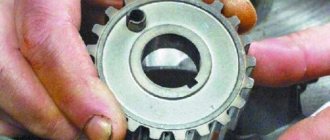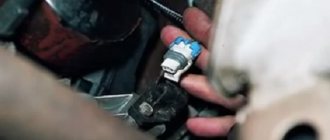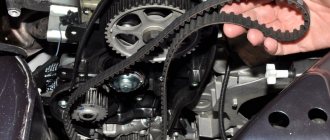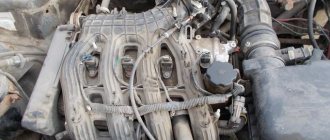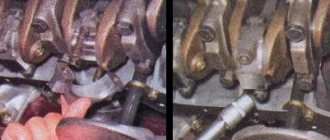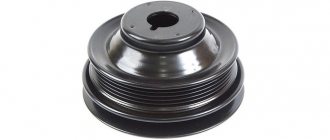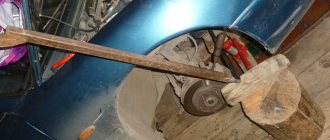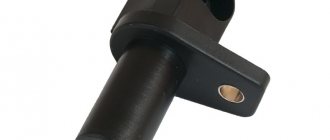So the record itself was formed when you weren’t expecting it at all =)
This morning I walk up to my car in the parking lot, start it and oh, joy - a specific knock from under the hood 8\ Well, my... The first thought that came to mind was the clutch. I sat down, pressed the pedal, nothing. I opened the hood, I could hear that the sound was clearly coming from the timing belt area 8\ Well, damn it, either the crankshaft pulley (damper) or the pump. The engine runs great, except for a colossal knock =))) As luck would have it, it’s also Sunday, half of the spare parts stores in the area are closed. I decided to go out of town, to the village to visit my mother, to my warm garage. On the way, I think I’ll just buy a pump or a pulley - I decided to look near the store. By the time I got there, I felt the car starting to slow down... More and more. Well, everything is clear, something happened to the damper. I didn’t make it to the store and got up. I called my uncle and asked him to tow me to my native collective farm. While I was waiting for him, I took off the wheel and boot and there it was, a handsome man, dangling, the bolt half-unscrewed.
I unscrewed the bolt, basically by hand, without straining too much, and there it was, joy.
I filled the whole thing thoroughly with Ve-Dashka, so that while I was removing the timing case and all that, the crease and the gear would eat off well. The gear came off calmly, without straining at all; even screwdrivers were not needed.
I took a small drill, put it in the drill and drilled a hole in the crook.
Then he removed the drill and sharpened it in the opposite direction
I put it in the drill and switched the reverse to reverse rotation. And inserting the drill into the drilled hole in the crook, he slowly unscrewed it using the drill
In principle, there is little work, but on the road you will do hell if you don’t have a screwdriver with drills with you. I didn’t have =)) and it was frosty.
Below is a comparison of the new gear and the old one - this is how the ebb should have been
And here is a photo for those who don’t know what the 2112 16kl damper looks like and what its advantage is over the 2110 8kl.
It is fixed on the gear many times more reliably than the tenth eight-valve one. My advice, if you have an eight-valve engine and it’s time to change the pulley (damper), then change it to a damper from 2112 16kl and the same timing gear, it costs a little more, but is ten times more reliable. In the process of work, I decided to replace the timing belt at the same time, mine was already a little eaten on the sides, Deykovsky installed it, the belts are good and their price tag is normal.
That's all, basically. The gear cost me 107 rubles. and crankshaft bolt 20rub. I spent more snot in the cold than money =))) And my day off was gone, damn it. I caught this unexpected one on Sunday morning =)
Everyone - survive these frosts and not break down at this time, it’s cold, damn it =)))
Source
Differences between pulleys 2112 and 21124
Level up! Sssyrna! Who knows what we'll talk about - three steps forward! Mmm, fuck you! That's right! To the location of Starship Troopers, goooom-marjshzh!
After repeatedly covering the Arcturus-Denebola section and, in particular, while moving along the rings of Saturn, the crew finally noticed the readings of the On-Board Computer - a phase sensor error. More precisely, the on-board computer has long been lost in air hockey in the space park, and the team is forced to take logs directly from the engine controller, waiting for a new one to be issued due to depreciation. Unsatisfactory dynamics and engine sound were also noticed.
Following the instructions, the phase sensor was replaced, which did not solve the problem. This was followed by reinstallation of the timing belt, at which time the following was noticed: it was impossible to set the marks clearly in their places. Although...the crankshaft mark is not visible because... no one in the port is bothered by removing the crankshaft pulley, and tunes the engine according to the 20th tooth of the DPKV.
No information was found in the intergalactic database. But we managed to find out the following: the mark on pulleys 2112 is located between the teeth, exactly opposite the key. My engine had pulleys 21124, the mark on which was shifted counterclockwise, according to the diamond eye, by 2 degrees.
2112 - pulleys, unlike all derivatives, do not contain welded circles to distinguish between models;
21124 - one circle on both types of pulleys at the base of the hub;
21126 - circles at the pulley crown. One is inlet, two is outlet. The tooth profile is semicircular; 11194 - circles at the base of the hub. Two is inlet, four is exhaust. The tooth profile is semicircular;
The enraged mechanic mercilessly applied new marks with an unprecedented tool inherited from his grandfather.
The engine was assembled, the marks were set, and it was started. The time has come to check for errors, they checked - there were no errors. At that moment, from the depths of space, over a long-distance radio communication channel, came the sound “... that’s it, Mikhalych...” The rest could not be made out, interference from deep space.
You can have different attitudes to all of the above, but for me, as a person with little experience in engine building, the story of bent valves became less scary, because... The engine was running on a timing mechanism that was installed incorrectly twice, a couple of teeth to the left the first time and to the right the second. The engine is non-standard - 1.5 liters with a prior piston and this engine spun up to the factory cut-off, went uphill in fifth gear, overheated, ran on a lean mixture, without oil when the camshaft plug flew out, etc. And perhaps the information will help some rangers behave more competently in bearing stores.
This week there will be a movement of 500 parsecs, let's see what happens with the dynamics and flow rate. The crew received instructions to especially carefully record all comments on the operation of on-board equipment. The long-distance radio communication channel was turned off out of harm's way. Come on out!
Source
Reverse actions
After removing the pulley, you can carefully examine it and put it aside for garage scrap metal. Take the new part in your hands and lubricate the key seat well with grease. Slightly tilting the key towards the hub, we slowly push the pulley onto the shaft. For this purpose, you should have a hammer in one hand, and in the other a piece of soft rubber, which is placed between the hammer and the body and prevents the hammer from damaging the crankshaft pulley.
Once the hub is in place, you need to tighten the fixing bolt. This must be done without any tricks: a wrench and a pipe will help tighten this bolt until it stops. To avoid turning the crankshaft when you begin to apply significant force to tighten the bolt, you need to lock it using a metal pin (large screwdriver), inserting the latter between the teeth of the flywheel ring. To do this, you need to open the clutch housing ventilation plug.
It is not recommended to tighten the bolt to the limit; you may miscalculate the effort and break it, and this is almost a disaster. To do this job correctly, you will need a torque wrench. As soon as the sensor shows a tightening torque of 400 N/meter, no further force is allowed.
The crankshaft pulley mounting bolt breaks or we install a damper from 1.6 16kl to 1.5 8kl.
Hi all. I want to tell you how I solved the problem with the crankshaft pulley key flying out. I'm far from the first to do this and this is not the only way. I did it today, if the problem comes up again (I highly doubt it), I’ll definitely write. So far I'm happy as an elephant. And that's the crux of the problem. The generator pulley mounting bolt breaks. Over the last year, about 15,000-20,000 thousand/km, it broke down about 6 times. Breaks the last 3.4 turns. Once I left a broken bolt and after 200 km another 2.5 turns broke off. After the bolt breaks, it unscrews and breaks the seats for the bushing and key on the pulley (the pulley immediately becomes unusable), but I continued to use it with a slight play. I tried to install a threaded bolt in the crankshaft gear instead of a bushing - it broke after 30 km. All this time I noticed a slight play in the pulley. I saw on the Internet how they solve the problem of cutting the keys and bushings, attach the pulley to the gear with bolts, steel rods, and weld the bushing on the back side of the gear.
I saw recordings of how to install a damper from 1.6 16kl and it seems to fit.
Somewhere ago I wanted to take a risk and buy a gear and a damper from 1.6 16kl, but the seller, having heard my problem, said that nothing would work and my problem was in the gear (wear), change it and there would be happiness (it was enough for 1000, then 2000) . And before the consultation in the store, the bushing came out 3 times in 1 day, 250 km. At first the bushing only fell out and I solved the problem by installing a washer to cover the bushing. After 2000 km it fell inside). Now I remember with a smile, it was a very poisonous disease, I drank a lot of blood. I poured a lot of water in the article, I’m writing to tell you more precisely, in case someone is struggling for a very long time with the same thing that I was struggling with. Also, the last time I tried to drill through the pulley and gear and add another key. After 200 km, it broke in half at the junction of the pulley and gear (just like the bolt once did). After the last breakdown, I thought about installing 3 keys (someone presses steel rods or installs bolts), but already freaking out, I decided to throw money away on a new damper and gear from 1.6 16kl. There was another moment when an annoying problem brought me back to the store because of a lost bushing. I again tried to buy a gear from 1.6 16kl, but the saleswoman said it wouldn’t fit! But for the first time she explained that this is due to the fact that the gear from the 1.6 16kl Priora has a round tooth shape (the timing belt will not fit) and it is wider. I didn't think then that I could swing the pump belt and the top gear. But even if I thought about it, I still wouldn’t change it (I just installed new everything). After this, thoughts about switching to a damper from 1.6 16kl disappeared without a trace.
Source
Possible faults
If it fails (beating and deformation, cracks and tears), the VAZ crankshaft pulley will most likely need to be replaced. After that, we get behind the wheel, ask the nervous neighbors in the garage to leave and start the car with a quick movement of the key. The starter should not turn for more than a split second. To do this, you need to open the clutch housing ventilation plug. To do this job correctly, you will need a torque wrench. As soon as the sensor shows a tightening torque of 400 N/meter, no further force is allowed. Don't forget to tighten the generator mounting bolts and reconnect the connector on the ignition coil.
If installed incorrectly, it may fall out, which will cause the hub to rotate. In case of lubricant leakage from under the crankshaft oil seal. When removing the crankshaft - for repair work, changing bearings, etc.
The complexity of this operation lies in the difficulty of dismantling and the problematic installation of new cuffs, instead of worn rubber bands, which become deformed over time and no longer perform their functions. In the manual for VAZ cars, this operation is described very concisely, since the algorithm itself is simple and should be easily implemented. The pulley we need is located under the hood of the car, where there is not much space. Usually this part is located behind the generator, near the body elements. We hope our tips will be useful and you can easily disconnect the crankshaft pulley.
Which crankshaft pulley is better, cast iron or damper VAZ 2112 16 valves
Why does it turn over, like there is only a generator in the load?
There is not a key there, there is a bulge on the crankshaft pulley, which usually turns the generator drive pulley with a rubber damper due to the age of the rubber.
The correct one with a damper, sometimes the damper turns this rubber, the cast one turns the key on the crankshaft.
Why does it turn over, like there is only a generator in the load?
There is not a key there, there is a bulge on the crankshaft pulley, which usually turns the generator drive pulley with a rubber damper due to the age of the rubber.
Why does it turn over, like there is only a generator in the load?
There is not a key there, there is a bulge on the crankshaft pulley, which usually turns the generator drive pulley with a rubber damper due to the age of the rubber.
In my opinion, the generator is driven through a rubber damper. And the pulley teeth are rigidly connected to the crankshaft.[/
quote]
The inner part of the pulley and the outer part where the teeth are located are made of metal and the inside is filled with rubber. that is, the teeth are not rigidly connected to the crankshaft, so when the rubber cracks and the pulley turns a little, then the dullness of the car begins, this is what happened to me. when the diagnostics showed that all the sensors were normal, they decided to rev up the throttle and accelerated to 5 thousand revolutions, the pulley turned by about 10 cloves. Therefore, the car stopped starting, since the dpkv was not receiving the data correctly. I replaced it with a completely cast iron pulley, the problem was solved, but it seems that the car has become a little dull, people say that the pulley cannot affect the dullness of the car.
Source
Purpose, design and replacement of the VAZ 2110 crankshaft pulley
VAZ engines have two, slightly different modifications of the torsional vibration damper and crankshaft hubs, in other words, the pulley. On a VAZ 2110, the crankshaft pulley can be made as a block, or also have a separate system with a hub - a damper. Cast iron crankshaft pulley
When the production of the “ten” had just begun, the crankshaft vibration damper was a single unit, and was secured with only one central bolt. Along with the injection VAZ 2110, a damper appeared. It is bolted to the hub.
How to choose a crankshaft pulley
There are quite a few parts in the car that, even when disassembled, may not be easy to notice. One of these parts is the crankshaft pulley - a small disc-shaped product that performs a very important task. Namely, torque transmission. In this article we will look at this problem “under a microscope” and also determine how to determine a faulty crankshaft pulley. We will also answer questions about the need to replace it and present a methodology for selecting spare parts. Let us note in advance that a pulley that does not attract attention quite rarely fails, however, in the event of a breakdown, the problem cannot be ignored - the performance of several car systems decreases.
Replacing the crankshaft oil seal 4 G93 - stage 2.
Next, one holds it with emphasis against, and the other turns out the pulley (damper) bolt.
11. But, unfortunately, no matter how carefully the owner treats his VAZ 2110, sooner or later the time for physical wear comes for the liners - they need replacement. The only exception is if it is replaced with a new one. At the same time, an experienced craftsman can turn the crankshaft into a lightweight one. When reassembling, please note that the groove on the hub must be aligned with the segment key.
Purpose and device
In the vast majority of cases, the outer part of the pulley is a disk with a periphery, which are connected by especially durable rubber. You can notice small notches and pits on the pulley - they are needed so that the part, which is mostly a heavy metal product, is balanced . A well-balanced pulley copes with the following tasks:
Why is it difficult to remove the pulley?
No. 1. Depending on the engine design, make and model of the car, the difficulty of removing the pulley varies. Some machines have a lot of space to comfortably carry out repair work, while others have very little free space. The pulley design elements cover the pulley.
The structure of pulleys is also different, there are 2 types:
- ordinary;
- damper
Damper pulleys have an additional outer ring with an elastic band in their design, which absorbs vibrations and micro-vibrations.
Before you start removing the pulley, you need to loosen the tension nuts and bolts, remove the generator and power steering belt.
No. 2. In the factory assembly, the pulley is seated on the engine crankshaft, pressed with a bolt or nut and tightened with high compression force. Thus, the factory assembly is very strong. Therefore, if you have never removed the pulley, it will be more difficult to dismantle it the first time.
In addition to tightening with the maximum permissible force with a special torque wrench, during operation, the engine becomes very hot, the threaded connection is tightened even more and sticks. And external factors influence the outside, due to which the threaded connection may be subject to corrosion.
Some engine models cannot be repaired; they are disposable. These are, for example: 1AZ-FSE, 3UZ-FSE. Each power unit was examined in detail.
No. 3. If you disengage the clutch, the engine crankshaft can be freely turned with a wrench. Therefore, in order to unscrew the crankshaft pulley nut, you need to stop the shaft from turning. If, when you press the clutch, the speeds do not change, then it is not working. Air may have entered the system. In this case, you need to bleed the clutch.
Why are special technological holes made in pulleys? In auto repair shops, there is a special device for fixing the shaft, which must be bolted to the pulley and the shaft locked.
If there is no special device for fixing the shaft, which is screwed to the pulley, then you need to install good anti-roll devices under the wheels of the car and put 4th gear on the gearbox.
Or, the third option is to rest a pry bar against the flywheel teeth and fix the crankshaft from turning while unscrewing the pulley nut.
Another option is to insert a pin into the pulley hole, and install a pry bar around the pin and the second stop, as in this figure.
Types of pulleys
As we wrote earlier, automakers can introduce various pulleys into the design of their cars. Although a part from a car of one brand may not be externally different from a part from another, there is always a difference. And the point here is not only in form, but also in balancing . However, pulleys are divided into several types. Namely:
All three pulleys have their advantages and disadvantages. It is important to understand that the design of the pulley also depends on how the elements adjacent to them are arranged and what are the features of their operation. The same damper pulleys made it possible to solve the problems of mechanical impacts and vibrations that occur when starting the engine and changing the frequency at which the crankshaft rotates. At the same time, the pulley damper fails quite quickly. Let's pay a little more attention to this.
Pulley removal
Unscrewing a fastening bolt or nut is only half the battle. Next you need to pull the pulley out of the shaft. The pulley cannot be removed easily by hand unless its seat is broken. In addition, if the pulley fits tightly onto the shaft, it is also secured against turning by a key.
There are special pullers for removing the pulley from the shaft. There are mechanical and hydraulic pullers.
The design of a mechanical puller is simple. Usually it has three legs, with which you need to hook the pulley itself, and rest the central rod against the shaft. After which, you need to rotate the rod, the legs will straighten and pull the pulley towards you.
There are even simpler pullers that you can make yourself. If there is no removable device for the pulley, then you can use pry bars. If one person is filming, then take turns, moving it a little on each side so that there is no distortion. If there are two, then at the same time, from different sides, the pulley is pressed out from the crankshaft with a sharp movement.
It also happens that when using a puller, the walls of the pulley grooves cannot withstand and break off. Therefore, when using pry bars, they must be engaged as close to the shaft as possible.
